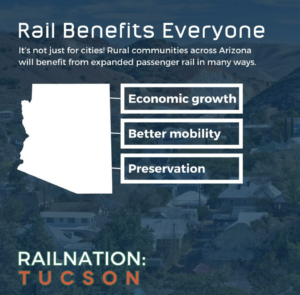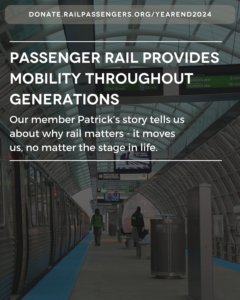Thursday, July 03, 2025
Thursday, July 03, 2025

By Lenny Zaleski
What do you do to drive awareness of policy issues when your organization’s issue is not top of mind for most people?
Transportation issues aren’t the first concern most people thought of during the 2020 or 2024 presidential election. According to Pew Research, the top issues for voters in 2020 and 2024 were the economy, healthcare, and Supreme Court appointments.
So, how can you drive awareness and engagement for supporters of transportation beyond a car when it isn’t largely present in the political zeitgeist of the U.S.?
That’s the question I had to work through during my volunteer work with the Rail Passengers Association, a membership-based nonprofit that advocates for expanded passenger, commuter, and subway rail in the United States.
Making the issue intersectional
When I was tasked with driving this awareness and engagement among passenger rail supporters, I realized that we had to expand this issue beyond just one thing. Selling people on something that costs money and takes time to build is not the easiest thing to do, and so the content the association puts out via email, socials, our newsletter, and our events had to go beyond just the actual thing we wanted – more trains in more places for more people.
It had to be about what that action could mean for people who would otherwise be uninterested in what we wanted to advocate for.
To expand this issue beyond just one idea into something that impacted people on a real, daily level, I had to look at what the data said. According to research Amtrak, the national provider of passenger rail service across the United States had put out, I had a lot to work with in terms of what passenger rail could mean to people who weren’t ardent supporters of it. A 2023 study they conducted gave me kernels of how the association could structure our content, including:
This information, along with several other studies I found while researching content ideas, formed the basis of how we would approach content the association made that advanced its mission – connecting rail to jobs, traffic issues, and environmental impacts.
Early steps in developing the association’s content strategy
When I got started, I worked through the content I had planned for the first month of running the social media platforms for the association, which included Facebook, Instagram, X (formerly Twitter), LinkedIn, and Threads. The early content I worked on for the Association hinted at the information people needed to get interested in the work we were doing, such as ridership gains, environmental benefits, economic development, and mobility issues people faced.
Much of this content was ideating – risks taken to see how it would perform and what we could tap into in terms of real results we needed to get on our digital content to help promote the mission of the association.

The first social media post I created for the association, showcased the gains Amtrak has made in 2024 in terms of ridership. The post exploded in terms of popularity, garnering thousands of engagements and dozens of comments and shares.
The results of our early approach to the content strategy brought us some incredible stats to show one month in, including:
This data showed me that we were on the right path to creating an approach to our content that would keep us relevant in our advocacy, engage supporters who were going to our website and talking to us about the issue we advocate for, and build something important: community.
Community became the defining approach of how we built our content – our goal was to build bridges (or tracks) to people who were interested in issues that were top of mind for people, like the economy, job creation, the environment, and more.
This approach would be tested when we ran our signature advocacy event, RailNation, in the fall of 2024 in Tucson, Arizona.
Marketing RailNation: Tucson
RailNation is one of the Rail Passengers Association’s signature events. In addition to its events held in DC at the nonprofit’s headquarters, the association also hosts locally led events with local organizations and individuals to raise awareness of passenger rail’s benefits and equip advocates to succeed in their efforts.
Through coordination with staff and statewide organizations, I worked on our marketing campaign for the event in Tucson, utilizing our content strategy and putting it under a microscope – how we could localize an issue to a community while also drawing in people from around the country to this event.

Image of a graphic I created to promote the event.
Some of our posts highlighted how expanded access to passenger rail could benefit their communities. Others looked at specific communities, such as rural ones, and how they could benefit. We kept this approach up through our newsletter, email marketing, and media outreach.
The result? 60 paid attendees to the event and collaborations with influencers like CityNerd who vastly expanded our outreach to intersectional supporters of public transit.
After this event, I continued to build upon the approach and further built a community for our supporters and people who had become invested in the development of passenger rail. Throughout my time volunteering with the association, we accomplished a lot in six months:

On top of these benefits for us, we were able to help spotlight issues beyond the national scope. We partnered with local organizations and citizens’ advocacy groups to bring attention to local issues, helping us reach new local demographics in cities across the country.
What comes next
For any organization with constrained resources, limited staff, or small budgets, the question is how the tools they have available can help execute their mission. One of the biggest lessons this case study can offer is just that – the tools will not be what helps drive the engagement. It will be the content. Figuring out how to endear the issue organizations advocate for is the name of the game.
By using content to not just serve the organizational needs but instead using it for mission-aligned narratives that show people the relevance of the problem beyond what core supporters may engage with, organizations can open themselves up to new advocates, supporters, and even donors.
+++
Lenny Zaleski is a student, writer and emerging communication professional based in Dayton, Ohio. He is a #WeLeadComms honoree.
Written by: Editor
© 2025 Stratpair Ltd., trading as Strategic. Registered in Ireland: 747736